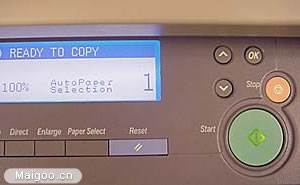Copier copying process In the copying machine, after exposure of the photoconductor of the toner cartridge, a latent image is formed on the surface of the toner cartridge in the form of electric charge. This image is then developed and transferred using a special charged toner. The following is the process of copying each part: 1. In order for the copier to function, a layer of cation must first be applied to the surface of the photoconductive material by a corona wire. The toner guide's selenium, tantalum or silicon surface is already covered with a positive charge before you press the start button. 2. When you press the “Start†button, the flash light sweeps through the inside of the copier, illuminates the paper to be copied, and the toner cartridge begins to rotate. When the blank area of ​​the paper reflects the light back, the mirror projects the reflected light onto the surface of the drum. Just as we wear dark clothes in sunny, hot weather, the dark areas of the original absorb light and therefore do not illuminate the corresponding areas on the surface of the drum. 3. Where the light hits the rotating toner cartridge, the energy of the photon kicks the electron out of the photoconductive atom. 4. Heterochromatic attraction - the cations outside the photoconductive layer attract the released electrons. The combination of an ion and an electron produces a neutral particle. The place where the charged particles are left is only the place where the original does not reflect the light and the light does not reach the toner cartridge, that is, the dark part of the text and the picture occupied on the paper! It's not too rigorous to say that this part of the process is similar to how the camera takes pictures. If you've ever read the basics of photographic film, you should know that when the film is exposed, the energy of the photon causes chemical changes in the film-coated silver halide particles. This will form a negative of the image you see through the viewfinder. But for the copier, what you end up with is a real image formed by the positive charge left after exposure. What's more, you have to use a special chemical process to develop the film and print it onto the photographic paper, while the copier only needs to produce visible images with dry ink, heat and plain paper. 5. A voltage is applied to the aluminum core of the toner cartridge. Since light makes selenium conductive, current can flow through the photoconductive layer as it illuminates the toner cartridge, and the electrons that form the current rapidly replace the electrons released by the atom. 6. The exposed area of ​​the toner cartridge is rotated by a roller that is coated with toner particles. Tiny toner particles are pressed onto the surface of the drum. The plastic toner particles have a negative charge and are therefore adsorbed to the positive charge region remaining on the surface of the drum. 7. The corona wire passes over the paper to charge the surface of the paper. 8. The area of ​​the drum that has just been coated with toner is in contact with the positively charged paper. The electric field around the paper produces a stronger suction than the surface of the drum, so the toner particles stick to the paper as it passes. 9. Once the entire original is recreated by the toner on the paper, the paper continues to the fuser through the copier. The weak suction between the toner particles and the surface of the paper is easily damaged. In order to fix the toner image at the corresponding position to the surface of the paper, the entire sheet of paper is passed between the heat rollers of the fuser. The heat melts the plastic material in the toner and fuses the pigment to the paper. When you reach out and take a copy from the paper feed tray, the copier has once again removed the surface of the drum and applied a new cationic coating to prepare for the next run. Large Makeup Bag,Cosmetic Pouch,Small Makeup Bag,Best Makeup Bags Ningbo Happiness Stationery Industrial & Trading Co Ltd , https://www.cnhappiness.com
Copier copying process
[Office Partner Information Center] In the copying machine, after the photoconductor of the toner cartridge is exposed, a latent image is formed on the surface of the toner cartridge in the form of electric charge. A detailed description of the copying process of the copier, such as developing and transferring the image, using a special charged toner.